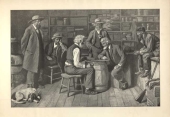The Checker Maven
The World's Most Widely Read Checkers and Draughts Publication
Bob Newell, Editor-in-Chief
Published each Saturday morning in Honolulu, Hawai`i
Contests in Progress:
A Trap With a Tale, Part 3: An Easy Tale

"It's easy when you know how" could also be the theme of today's little study, but we think the deeper truth is found in another adage: When someone makes something look easy it's because they've worked hard.
We're continuing with one of the final chapters of Willie Ryan's Tricks Traps and Shots of the Checkerboard with a problem that's easier than usual, "An Easy Tale" if you wish; at least, it's easy if you've worked hard enough at your visualization skills.

Let's begin with a run-up that we've already seen a couple of times, so no further commentary is required.
| 1. | 11-16 | 24-19 |
| 2. | 8-11 | 22-18 |
| 3. | 16-20 | 25-22 |
| 4. | 9-13 | 29-25 |
| 5. | 11-15 | 18-11 |
| 6. | 7-16 | 22-18 |
| 7. | 20-24 | 27x11 |
| 8. | 10-15 | 19x10 |
| 9. | 6x29 | 28-24 |
| 10. | 29-25 | 32-27 |
| 11. | 1-6 | 24-19 |
Recall that Willie said this move draws, but last time we showed that if Black plays the odd-looking 25-29, Black would have actually won. However Willie gave this as the next move:
| 12. | 6-9 |
which only draws (even if the White draw is very narrow). We'll follow that path further next time, rather than stopping here with "White to Play and Draw." Instead, we'd like to look at what happens if White makes this seemingly feasible move:
| 12. | ... | 23-18 |
resulting in the position below.

BLACK
Black to Play, What Result?
B:W31,30,27,26,21,19,18,11:BK25,13,12,9,5,4,3,2.
We're pretty sure you know what the outcome will be, but can you show it? It truly isn't all that difficult, but it's definitely a lot of fun. Tell the tale and then click on Read More to verify your solution.![]()
Double Arrow

Onward and upward! Do these two arrows point the way to success? And will that success be on the checkerboard?
Today's Checker School entry, a position attributed to William Strickland, certainly looks like two arrows pointing upward -- from the Black side. (From the White side, the arrows point in a quite different direction.) Let's take a look.
WHITE
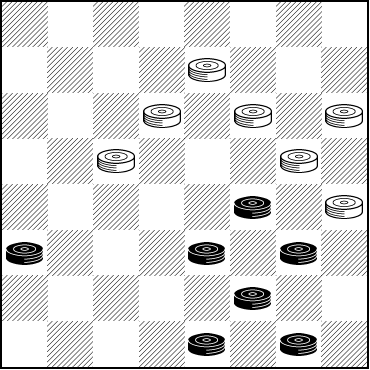
BLACK
Black to Play and Draw
B:W26,23,22,21,19,17,13:B14,12,10,9,6,2,1.
In the interest of fairness, we presume, the terms are Black to play and draw, and that would certainly be a success in such an awkward position. As for White, it's his game to win ... if he can.
Will your arrow hit the mark? Solve the problem and then shoot your mouse onto Read More to see the solution, explanatory notes, and seven--- yes, seven--- sample games.![]()
The Brooklyn Position

Brooklyn, New York, has got to be the center of the hipster movement. Now, a hipster is supposedly "a person who follows the latest trends and fashions, especially those regarded as being outside the cultural mainstream."
By that definition, checker players would not exactly be hipsters, yet many a top player has had humble origins in Brooklyn. Perhaps times have changed. But checkers does have the Brooklyn Position, and that's the topic of today's Checker School entry.
We've seen the Brooklyn Position at various times in previous columns, but today we present an in-depth study. The solution, accessible by clicking on Read More, gives half a dozen sample games that run into this position. It's well worth the time and effort to study it carefully.
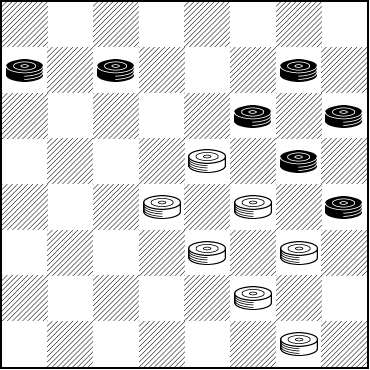
WHITE
White to Play and Win
W:W32,27,24,23,19,18,15:B20,16,12,11,8,6,5.
Are you hip, or just a drip? Show your stuff, and find the solution. It's actually not so difficult, and you might even think it's kind of trendy.![]()
A Trap With A Tale, Part 2
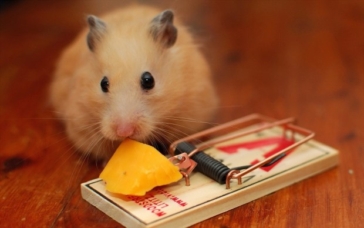
Watch out! That tempting bit of cheese will come at a stiff price ... unless that little white mouse can somehow avoid the trap. Yes, today we're continuing our Willie Ryan series, A Trap With A Tale.

In our last excerpt from Willie Ryan's classic Tricks Traps & Shots of the Checkerboard, we showed the run-up to a position that turned out to be a Black win. The solution to that position included a computer move with which we'll see that Willie Ryan, in his book, disagreed. It's much easier to show than tell, so here goes.
| 1. | 11-16 | 24-19 |
| 2. | 8-11 | 22-18 |
| 3. | 16-20 | 25-22 |
| 4. | 9-13 | 29-25 |
| 5. | 11-15 | 18-11 |
| 6. | 7-16 | 22-18 |
This was the point at which we asked you to find a Black win. Now let's look at a possible alternate continuation, the one preferred by Willie, which he claims leads to a draw instead of a Black win.
| 7. | 20-24 | 27x11 |
| 8. | 10-15 | 19x10 |
| 9. | 6x29 | 28-24 |
| 10. | 29-25 | 32-27 |
| 11. | 1-6 | |
Here the computer played 24-20 and showed a Black win, as we presented in our previous column. But Willie instead gives this to draw:
| 11. | ... | 24-19 |
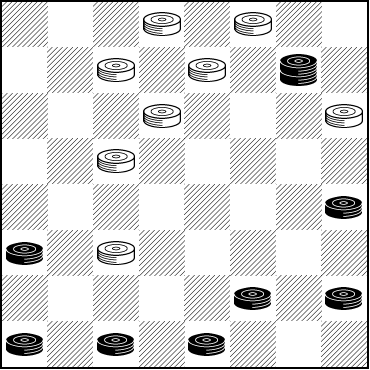
BLACK
Black to Play, What Result?
B:W31,30,27,26,23,21,19,11:BK25,13,12,6,5,4,3,2.
Who is right, Willie or the computer? Can Black still win against Willie's preferred defense?
We think you know the answer, but can you show the Black win?
Willie stars this as the only move to draw; the computer move was instead 19-16 and White went on to lose.
Who is right, Willie or the computer? That's the question we're asking you to answer in today's column. This is probably a master-level problem, but if you followed the solution from last time, you'll have a broad hint as to what will happen here.
Take on Willie or take on the computer, and see how you do. At the heart of the position is an important over-the-board playing principle. When you're ready, click on Read More to see the solution.![]()
A. Jackson, Duelist
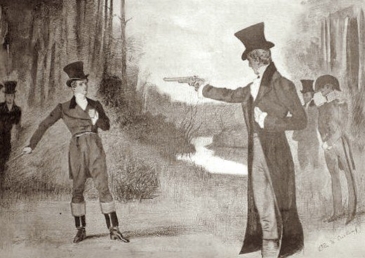
Andrew Jackson, seventh President of the United States, certainly wasn't the author of today's Checker School study; President Jackson passed away a good forty years before this position was first formally presented. But did President Jackson play checkers? It's been speculated by historians that he was a chess player, and it seems quite likely that, at the very least, he would have known how to play the game of checkers. But his favorite sport was apparently dueling; he is reported to have participated in some hundred duels!
Fortunately, a checker duel has far fewer permanent consequences than the type of dueling President Jackson did. Let's, for instance, look at the position below.
WHITE
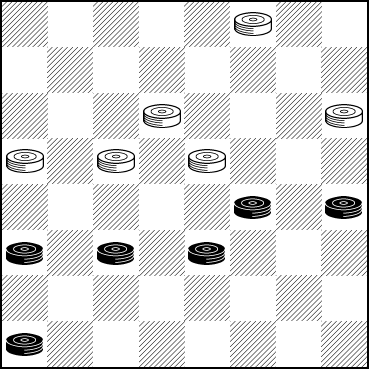
BLACK
Black to Play and Draw
B:W30,23,21,20,19,18:B14,13,12,11,10,4.
"Play and Draw" has little application to dueling (unless you're drawing pistols), as obtaining a draw in a duel isn't the point. But here, getting a draw with the Black pieces represents a respectable achievement. Can you do it? No pistols or swords needed, just good over the board checker skills. Solve the problem and shoot (or stab) your mouse on Read More to see the solution, sample games, and explanatory notes.![]()
Dunne It Again

We found the above inspirational poster very appropriate to our weekly column, for doesn't checkers mirror life in so many ways? Trust in our abilities, a belief in our capacity to succeed and to do what we have to do; these attributes apply both to the game of checkers and to life in general.
Someone who has Dunne-it before and now has Dunne-it again is our old checker friend, F. Dunne. We've seen his studies and positions before, and today we have another one that is subtle and interesting. It's our Checker School entry for this month.
BLACK
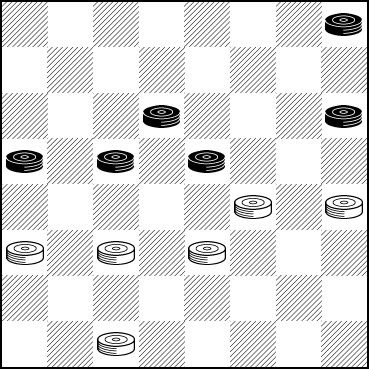
WHITE
White to Play and Draw
W:W30,23,22,21,20,19:B15,14,13,12,10,4.
Can you solve this and find the White draw? There's another inspirational saying from none other than Henry Ford: "Whether you think you can or think you can't, you're right." Trust in yourself, think positive, and click on Read More to see the solution, sample games, and explanatory notes.![]()
A Trap With A Tale 1

We can bet that this woman has a pretty interesting tale to tell about installing a sink trap. It can be a messy job and a lot of things can go wrong. But it appears she's found a solution in the form of long-lasting plastic components.
Which, of course, brings us to our subject: finding a solution, not for drain problems, thank goodness, but for equally perplexing checkerboard conundrums.

Today we're continuing with our presentation of material from Willie Ryan's fascinating Tricks Traps & Shots of the Checkerboard with the first part of something Willie calls A Trap With a Tale. We know you'll find it interesting, as we've discovered some unique things about this study. We'll give the runup without Willie's notes; those will come in later columns, but for now we want to cut to the chase.
| 1. | 11-16 | 24-19 |
| 2. | 8-11 | 22-18 |
| 3. | 16-20 | 25-22 |
| 4. | 9-13 | 29-25 |
| 5. | 11-15 | 18-11 |
| 6. | 7-16 | 22-18 |
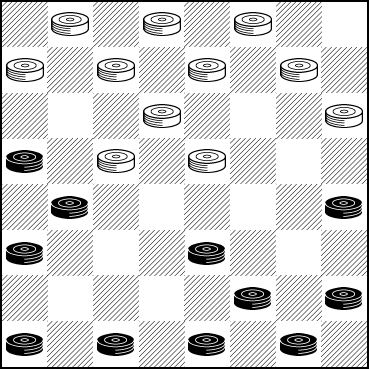
BLACK>
Black to Play, What Result?
W32,31,30,28,27,26,25,23,21,19,18:B20,16,13,12,10,6,5,4,3,2,1.
This one is not so easy and correct play requires what was once called "sticktoitiveness." Can you tell this tale or will you remain trapped in erroneous play? Patience is the watchword. When you're ready, clicking on Read More will indeed tell the tale in the correct manner.![]()
Transcription Error?
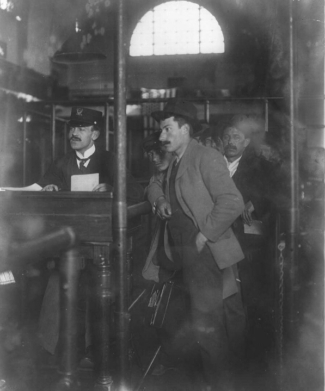
We quickly found out that "Subkow" is one way to transcribe a Russian name that is sometimes rendered as "Zubkov" or "Zoubkov". Since the "S" and "Z" sounds are clearly delineated in Russian, we can only think that here is another story about fanciful transcriptions done by monolingual Anglophone immigration officials who just wanted to write something down and be done with it.
In any case, there are perhaps a half-dozen Subkows in the U.S., and it's quite likely that one or more are related to checkerist William Subkow, who is credited with the following problem circa 1930 or so. It's our Checker School entry for this month.
WHITE
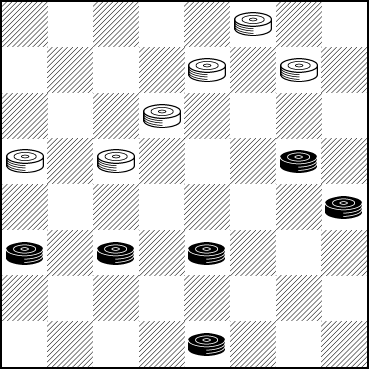
BLACK
Black to Play and Draw
B:W30,26,25,23,20,19:B17,13,12,11,10,2.
You'll see right away that Black doesn't have much in the way of good moves; that's never a favorable sign. In fact, we'll give you a hint of sorts: There is only one initial move to draw, and that's no transcription error. The solution is a bit on the long side, but it's quite logical, although there are a couple of interesting ways to go wrong for both Black and White.
Can you find the right moves and transcribe them properly, in order to better check them after you click on Read More? That will take you to the solution, several sample games, and detailed explanatory notes.![]()
Schaefer is the ...
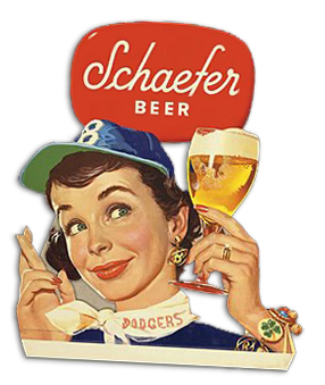
Was checkerist A. Schaefer in any way connected to the famous, and once family owned and New York based, F. & M. Schaefer Brewing Company? It's one of those things that are possible, but doubtful. In any case, Schaefer, like all New York City breweries, left the city many years ago, and is now owned by Pabst, who still operate the brand.
Schaefer used to advertise itself as "the one beer to have when you're having more than one." In all honesty, The Checker Maven doesn't think "having more than one" is always a good idea (we ourselves choose not to drink alcoholic beverages). If you've "had a few" as the saying goes, you're not likely to be able to solve interesting Checker School problems such as the one below.
WHITE
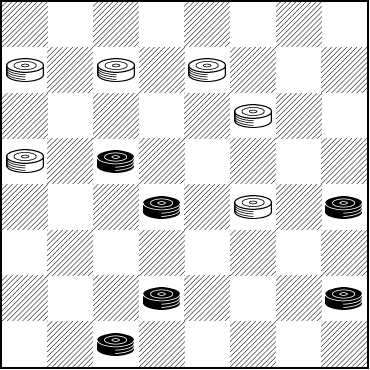
BLACK
Black to Play and Win
B:W28,27,26,22,20,14:B19,15,13,7,5,3.
Black actually looks like he could lose if he's not careful. How is he supposed to win? But there is a way, and it's subtle and pleasing with a key move at a key moment. You won't need "more than one" checker problem today, as this one is very satisifying. Give it a try and then click your mouse --- just once --- on Read More to see the solution, sample games, and detailed notes.![]()
A Little Lesson

The young fellow above seems to be having some trouble with his lesson, at least judging by the state of the blackboard, the look on his face, and the number of books piled up beside him. Could those possibly be checker books, and might the bottom one be a library edition of Complete Checkers? We can't say for sure, but one can always hope.
In today's Checker School entry, we present a little lesson with a big payoff. The position is shown below.
BLACK
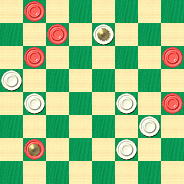
WHITE
White to Play and Draw
W:W27,24,19,17,13,K7:BK25,20,12,9,6,1.
What can White do here? The man on 17 is doomed and apparently White can only shuffle his king around and wait to lose. Yet there is an astounding draw here, one most worthy of the Herd Laddie. We call this a "little lesson" because Ben Boland was unusually brief in his commentary and there is only one sample game. Nonetheless we're certain you'll love this study, which is now approaching 150 years in age.
Give it a little try and then click your little mouse on the little Read More button to see the larger than life solution.![]()
The Checker Maven is produced at editorial offices in Honolulu, Hawai`i, as a completely non-commercial public service from which no profit is obtained or sought. Original material is Copyright © 2004-2025 Avi Gobbler Publishing. Other material is the property of the respective owners. Information presented on this site is offered as-is, at no cost, and bears no express or implied warranty as to accuracy or usability. You agree that you use such information entirely at your own risk. No liabilities of any kind under any legal theory whatsoever are accepted. The Checker Maven is dedicated to the memory of Mr. Bob Newell, Sr.

